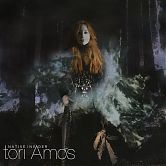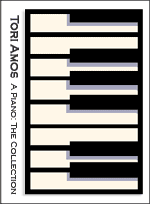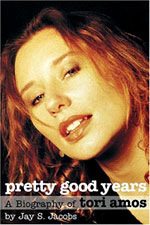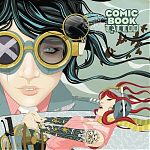- Articles
- Cherries
- Minutiae
- Q&A
- RAINN
- Releases
- Reviews
- Site News
- Them
- Toriphiles
- Touring
- TV/Radio/Web
- Video
News Archives
Keep an eye on our Twitter and Facebook pages since we often post quickie updates there when we're on-the-go.
During tours, we do our best to cover setlists in real-time on Twitter. If you want to tweet a show in, just DM or @ us on the day and tell us to watch your stream that night.
Tori is touring in 2017 to support the release of Native Invader. The European legs runs from early September through early October and the North American leg runs from late October to early December. We do not know if additional dates elsewhere will be added.

Native Invader (album, 2017)

Unrepentant Geraldines (album, 2014)

Gold Dust (album, 2012)

Night of Hunters (album, 2011)

Midwinter Graces (album, 2009)
 Abnormally Attracted To Sin (album, 2009)
Abnormally Attracted To Sin (album, 2009)
Live at Montreux 1991/1992 (DVD, 2008)

American Doll Posse (album, 2007)

A Piano (boxed set, 2006)

Pretty Good Years
(bio, 2006)

Fade To Red
(DVD, 2006)
 Comic Book Tattoo (book, 2008)
Comic Book Tattoo (book, 2008)News: The Daily Interview (September 26, 2011)
Don’t you think there was a time, what, in the ’20s, when the idea of art being challenging was what art was? And now, so much of it, you’ve heard it once, and you’ll say to yourself, ‘Oh, hang on a minute, that’s just like another song that I heard on the radio two hours ago, which is just like another song I heard last week …’ There is, right now, not an encouragement from those that are setting the trends — I’m not talking about the artists, I’m talking about labels, even the radio. They’re not always supportive of challenging the masses. I think sometimes they fear that, because what if the masses wake up and decide that they don’t need all these institutions and corporations and can’t be led by them because they’re thinking for themselves?
The Daily has a unique article on Tori, up today, in which they interviewed her and took some stunning photos in a Manhattan warehouse which has turned into the interactive set of the New York production of “Sleep No More.” Writer Rich Juzwiak ruminates on the new album, Tori’s history as a musician, her propensity for the impenetrable, and her ability to be down-to-earth at the same time.
EDIT: Check out additional images from the photo shoot by Victoria Will here. Thanks, Mario!
Bridge player
Tori Amos tells of connecting pop and classical, song and story on new album
BY RICH JUZWIAK MONDAY, SEPTEMBER 26, 2011
Tori Amos is fierce. This bit of information may come as no surprise to those aware of her advocacy, her lyrical imagery, her shattering wails or her ability to unify the full percussive and melodic capabilities of the piano in a single succession of plunks. But even the most devoted in her legions of fans might be shocked to see her model in front of a camera. She works it. Hard. Amos intuitively changes expressions and positions ever so slightly between frames, giving exactly what the photographer asks and producing impromptu poses of her own.
On one hand, this makes sense, because she is a pop star, and has been since her solo debut, 1992’s “Little Earthquakes.” On the other, this level of savvy is unprecedented for someone of her artistic league. How many other pianists releasing an album on the revered German classical imprint Deutsche Grammophon does the camera also love? How many does the camera even like?
But then, Amos’ ability to walk the walk while composing her ass off is part of a motif that repeats throughout her past two decades of work. For her entire career, Amos has been building bridges. Sometimes she does this physically, as she does in concert when she straddles her piano bench like a horse, turned out toward the audience with her left hand on her Bösendorfer piano and her right hand on a Hammond B-3 organ. More often, it happens abstractly in her music, as Amos bridges the gap between piano-based compositions and pop, between confession and relatability, between really deep thoughts and sing-along choruses.
“I think [a bridge] is a good thing to be,” said Amos, after posing for The Daily on the interactive set of the New York production of “Sleep No More” — a Manhattan warehouse turned into “The McKittrick Hotel.” “Worlds don’t need to be disconnected from each other. They can have parameters and edges. Edges are not bad things. And cliffs and all of that. But you want to be able to traverse from worlds, so there need to be portals. And if you can act as a portal as a musician, then it’s incredibly gratifying.”
Her 12th album, “Night of Hunters,” released last week, may be her most gratifying of all. It unites musical themes from 400 years of classical compositions by the likes of Bach, Deubssy and Chopin with Amos’ musical mastery, her voice and her flair for mythology in what she calls a “21st century song cycle” — a fluid narrative of love and loss that takes place from one dawn to one dusk.
On a felt couch in the corner of the McKittrick Hotel’s concert room, so dark that I couldn’t see the display on my recorder a few feet away, she explained her new album. “This isn’t a record that says, ‘Tori goes classical,’ ” she said. “This is a record that is about two worlds merging, and being a sonic architect.”
Time is often an abstract concept on “Hunters.” There are no drum machines to keep her at a steady pace — on the entirely acoustic album, she’s joined on her piano only by strings and woodwinds. Amos portrays herself as protagonist, hurtling through the ages, trying to learn more about the foundations of the disintegrated relationship that is the main subject of the song cycle’s narrative. I can barely see Amos’ eyes as she goes on, but that matters little as she gamely does her thing and builds a communicative bridge in the dimness.
There is something grand about Amos that feels theatrical. During the photo shoot, the photographer, Victoria Will, attempted to make her more comfortable with small talk. Amos took so long between responses that it made me wonder if she heard the questions. “Have you seen ‘Midnight in Paris?’” asked Will. Beat. Beat. Beat. Beat. Beat … Beat. “I did see that,” Amos finally responded. “I enjoyed that.” She’s quicker with me, but just as deliberate. That’s another work motif.
“When [Deutsche Grammophon] approached me [to make ‘Hunters’], I just stopped dead in my tracks and thought, ‘This is not a side project. This kind of project is every cell of your being or don’t pick up your pen,’” Amos said. The label specifically asked her to put her spin on older compositions. At the time, Amos had recently completed her contract with Universal Republic (her last studio album was 2009’s “Midwinter Graces”), and was years into work on the upcoming British National Theatre-bound musical “The Light Princess,” due to hit the stage in 2012. Amos credits theater training by greats such as director Marianne Elliott (“War Horse”) for facilitating the multi-character narrative that is “Hunters.”
In the album’s narrative, Amos’ lovesick character is guided through time by Annabelle, played by Amos’ own tart-voiced 11-year-old daughter, Natashya “Tash” Lórien Hawley, whom Amos says she called on for her acting ability. Annabelle shape-shifts from fox to goose, and performs a peyote ritual, which steers Amos to the moon and then to the ghost of her estranged lover, who then hands her off to the Fire Muse, played by Amos’ niece, Kelsey Dobyns.
If this sounds dense, it isn’t the half of it, since the way it plays out on the record is often through obscure imagery and suggestion. Promo copies of “Hunters” were sent out to critics with three pages of narrative explanation, and the CD comes with several photos of Amos and her daughter acting out the epic tale of lost love.
Density has been a constant in Amos’ career, but so has explanation. As much as she’s been criticized for opaque lyrics that beg for listeners’ empathy while giving little tangible in return, Amos has always been there to sort things out, whether it’s by chatting between songs in concert, devoting a book to her process (which includes numerous song dissections), providing commentary to her videos on a DVD compilation or fielding questions from interviewers like me, whose job is to demystify someone who mystifies as a matter of course. Perhaps there is an economy that has been hatched from explanation, but Amos’ willingness to be a key to her own world doesn’t come off as crass — it’s just another bridge for the builder.
“Think of all the great painters, and the impressionists, when you would stand and look at a picture,” she said. “Don’t you think there was a time, what, in the ’20s, when the idea of art being challenging was what art was? And now, so much of it, you’ve heard it once, and you’ll say to yourself, ‘Oh, hang on a minute, that’s just like another song that I heard on the radio two hours ago, which is just like another song I heard last week …’ There is, right now, not an encouragement from those that are setting the trends — I’m not talking about the artists, I’m talking about labels, even the radio. They’re not always supportive of challenging the masses. I think sometimes they fear that, because what if the masses wake up and decide that they don’t need all these institutions and corporations and can’t be led by them because they’re thinking for themselves?”
Amos challenges with “Hunters.” While certain musical themes careen in and out like choruses, there are few hooks, and no “repetition for repetition’s sake because you’re trying to sell a tune,” as Amos put it. “Hunters” is more pop than pretty much any classical album you can lay ears on, but it’s less pop than anything else she’s released. She said she initially toyed with the idea of using lyrics that quoted great poets, but Deutsche Grammophon’s Dr. Alexander Buhr dissuaded her from using others’ words to tell her character’s story. She eventually relented, coming to see the poetic quoting as “safer.” Safer isn’t what she wanted, deciding, “You gotta go for danger.”
And while her respect for the composers she invokes is apparent (she calls theirs a “passionate union”), so is the anti-patriarchal streak of a woman who was all over modern rock radio in 1994 singing, “God, sometimes you just don’t come through / Do you need a woman to look after you?”
“I found it very erotic that I had to become the penetrator of the dead guys,” said Amos. “Their music was the seed and I had to go into this egg form.”
And, as it so often happens in Amos’ work, the figurative begat the practical.
“I’ve been so opened by working with the great masters’ works,” Amos explained. “I’ve been changed, because I discovered new ways of composing, and [it’s] no different than the musical. I think these are the two biggest things that have happened to me in my life, and they’re happening simultaneously. They’ve been feeding each other back and forth and back and forth, and just when you think you’re at the bottom of your well, then I turn a corner and there’s the Pacific Ocean.”
On “Hunters,” for every line that reads as impossible (“There is a grid of disempowerment / And forces are being called to dismantle this”), there’s another that is practical (“Why do we women give ourselves away? / We give ourselves away thinking somehow that will make him want to stay”).
Amos strikes a similar balance between fantastical and literal in conversation. Her quotes here may seem ethereal, but she gave a down-to-earth guffaw when asked if she’s tired of explaining herself, and a goofy, throaty “ACK!” when I suggested that she could be fussier, after she noncommittally asked her publicist for “just something cool” to sip on.
She is, after all, a star — one whose airspace is close to the ground. She knows the game well enough to never let on that she’s a player. She is receptive to interpretation of her work and happy to hear comparisons to older achievements (“Oh, good!” she said when I told her that “Hunters” reminds me of 1994’s “Under the Pink”). She is gently corrective when she disagrees — she revised a suggestion that what she’s done with other composers’ work is “acoustic sampling,” by explaining that replaying variations on themes is far form manipulating existing mastering and is, in fact, part of the classical tradition.
But there is also a tension, a darkness beyond the shadows we were sitting in. With time running out, I brought up another career motif, this one external. In several reviews of “Hunters,” she has once again been compared to the also fantastical, piano-oriented and octave-leaping Kate Bush. I could tell immediately that Amos didn’t like the question’s direction, even though what I wanted to know is if the comparisons frustrate her.
“No …” she said, trailing off. “I don’t think Kate’s really done variations on classical themes,” she said finally. Indeed, Bush has not, but 2005’s “Aerial” was Bush’s own domestic song cycle that takes place over 24 hours (“Hunters,” in contrast, runs from dusk till dawn).
What’s left unsaid is that the way the two works diverge from similar premises should obliterate the rip-off question once and for all. After another uncomfortable pause, Amos turned serene and, like the pro she is, revealed her classy last words for me: “I think you have to know what your work is.”


